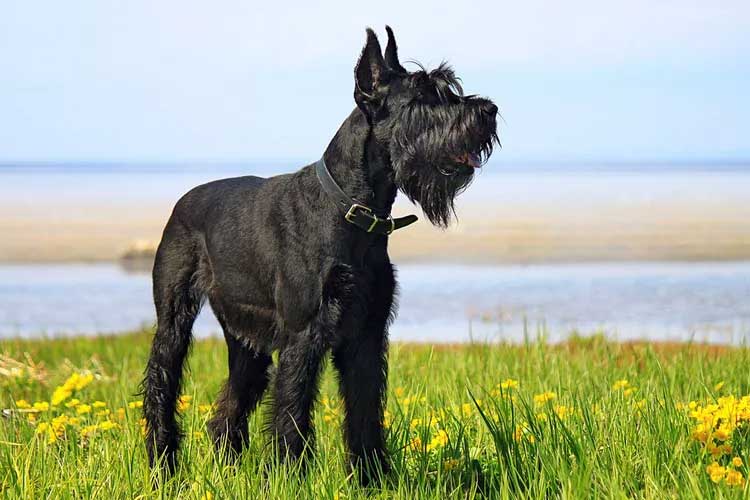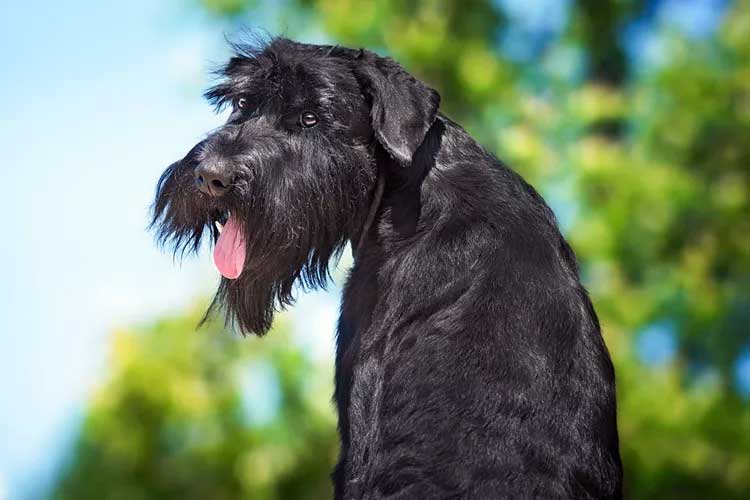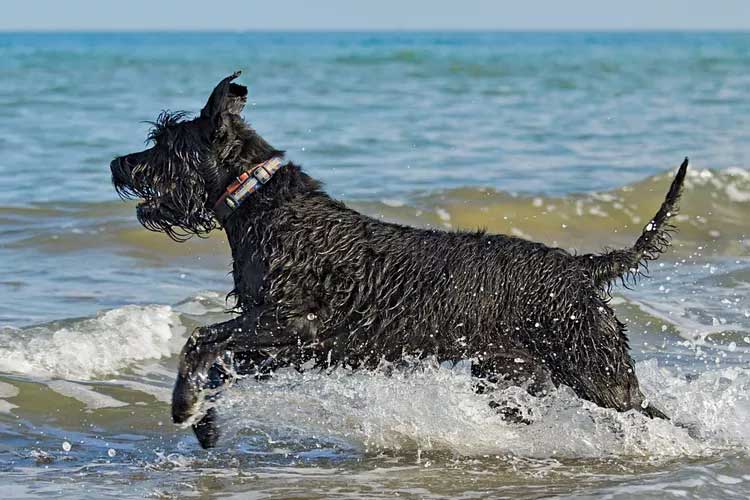Giant schnauzers are loyal, intelligent, and hard-working dogs who are great companions for those willing to train this high-energy breed. Here's hoping you have the time for long walks and playtime in the yard.

Giant Schnauzer Overview
| OFFICIAL NAME | Giant Schnauzer |
| COMMON NAME | Giant Schnauzer |
| PET HEIGHT | 23 to 27 inches |
| PET WEIGHT | 55 to 85 pounds |
| LIFESPAN | 12 to 15 years |
| GOOD WITH | families |
| TEMPERAMENT | aloof, friendly, gentle, willful |
| INTELLIGENCE | high |
| SHEDDING AMOUNT | infrequent |
| EXERCISE NEEDS | high |
| ENERGY LEVEL | active |
| VOCAL LEVEL | when necessary |
| DROOL AMOUNT | low |
| BREED GROUP | working |
| BREED SIZE | large (61-100 lbs.) |
| COAT LENGTH | medium, wiry |
| COLORS | black, fawn, gray |
| PATTERNS | black and tan |
| OTHER TRAITS | cold weather tolerant, easy to train, good hiking companion, hypoallergenic, requires lots of grooming, strong loyalty tendencies |
Giant schnauzers are as advertised (they can weigh up to 85 pounds) and have plenty of energy, but with the right training they become one of the most loving, loyal companions and make the effort well worth it.
Majestic and proud, these large dogs can stand more than 27 inches tall, clocking in as a much larger version of their smaller cousins, the standard and miniature schnauzers. With the right obedience training and surroundings—they probably aren't a good idea for novice dog owners—the giant schnauzer can be a playful family dog well into old age.
Appearance
The tall, sturdy dogs are hard to miss. Much like his smaller cousins, the giant schnauzer has a dense, wiry coat that's usually black or a salt-and-pepper mix, though his fur can also be fawn or black and tan. His characteristic beard and impressive eyebrows that frame those dark oval eyes will regularly need trimming to stay sleek.
The giant schnauzer is a minimal shedder and might be a good fit for some allergy sufferers, though periodic grooming is needed to keep his wiry coat neat and healthy. And while no dog is completely hypoallergenic, schnauzers of all sizes are widely considered to be a great choice for people with dog allergies, though that also depends on the specific person and dog. Before bringing home a giant schnauzer puppy, spend time with the breed to see how your allergies react.
Temperament
Giant schnauzer temperament is generally proud, friendly, and affectionate, provided they've been properly socialized and trained from a young age. Because of their large size and larger-than-life personality, the giant schnauzer is not a dog suited to first–time owners or those who are unable to follow a consistent obedience training schedule. But if you do the work, there's plenty to love about owning a giant schnauzer.Ed Fojkit, an American Kennel Club registered breeder and owner of Tanglewood Giant Schnauzers, grew up with giant schnauzers and says they are playful dogs who cherish every moment with their people.
"They make tremendous couch potatoes … or go out in the yard and play Frisbee," Fojkit says.

As a working dog who was bred to guard their people and even livestock, the giant schnauzer has a rich history of having a strong prey drive, meaning you may want to consider keeping him as the only animal in the house. They could chase cats or smaller animals, even other dogs. But if they're well-socialized from puppyhood and properly introduced to other pets, giant schnauzers can live well with furry roommates.
Because of their size and high activity level, giant schnauzers are best suited for people with the time and energy to devote to long play sessions in the yard. They can do well with children, but small kids need to be supervised and taught how to properly interact with animals.
Giant schnauzers are highly intelligent, and Fojkit describes them as phenomenally trainable dogs, joking that owners "could almost train them to cook you dinner." Because of their intelligence and trainability, this breed has been used in police forces and militaries across the globe.
Living Needs
Giant schnauzers are energetic dogs who need a lot of exercise, so they're best matched to a home with a large, fenced-in yard where they can run and play. If you don't have a yard, you'll want to plan on regular long walks to give them exercise. Shlomo Frieman, DVM, founder of the Animal Hospital of Factoria in Bellevue, Wash., says the dogs make great hiking companions and that it's going to be hard to wear them out no matter how long you walk or play.Giant schnauzers are usually happiest as the only dog in your house, but it's possible they can get along well with other pets if they're properly socialized with them as a puppy. Besides, owning a giant schnauzer requires a fair bit of work to burn off all that energy—you may not have the attention to lavish on other pets.
As a working dog, giant schnauzers are most content when they have a job to do, whether that's simply playing fetch, darting through agility courses, or attending obedience training—all things they excel at. Smart dogs like this need to be stimulated physically and intellectually, and giving them what they need will make living with them much easier than trying to fight their natural desire to be working and occupied.

You need to consistently be around your dog, too, according to the Giant Schnauzer Club of America. Your giant schnauzer wants to be with you pretty much all the time and requires a fair bit of attention. This highly intelligent breed doesn't cope well when left alone for long periods of time, so owners run the risk of their giant schnauzer developing undesirable behaviors if they are lonely and anxious.
Care
Grooming is a rather intense affair when you own a giant schnauzer. They have a dense, weather-resistant double coat. And while they barely shed (which gives you the upside of not constantly needing to vacuum up their fur), you will need to trim them in order to keep them neat and tidy."Their hair will grow and grow, so you can end up with them looking like an Afghan [hound] if you don't take care of it," Fojkit says, adding that owners can expect to visit the groomer every six weeks without clipping the coat themselves. On top of that, you'll need to brush them weekly and stay on top of any tangles.
Because giant schnauzers are such smarty-pants, they are considered easy to train. Consistency and positive reinforcement are key. These dogs have a strong desire to please their owners, so if you're willing to put the work into proper training, you'll be rewarded with an incredibly loyal and loving companion.
Health
Somewhat unusual for a breed of this size, giant schnauzers have a long average lifespan of 12–15 years and relatively few health issues. Frieman says giant schnauzers benefit from the fact that they aren't that popular."When there are lots of people trying to breed a certain type of puppy, it can lead to genetic issues because not everybody is being as careful as they should be to screen these things out," Frieman says.
Giant schnauzer owners should be aware of gastric dilatation-volvulus (GDV) complex, a potentially life-threatening problem that can affect large-chested dogs. Known more commonly as bloat, the condition occurs when the dog's stomach twists and cuts off blood supply, sometimes causing death in a matter of hours. However, there's a way to hopefully avoid the frightening condition.
"When we spay or neuter any dog of this size, we recommend a simple procedure that stitches the stomach to the body wall, which stops it being able to twist," Frieman says. "It should be a no-brainer to anyone looking to own any giant breed dog."

As with other large breeds, giant schnauzers can suffer from issues like dysplasia in their hips and knees, and Frieman suggests talking about these with your giant schnauzer breeder so that you are fully informed of any medical history in their lineage. It's also important to keep regular vet visits a priority so they can help identify warning signs.
History
The giant schnauzer originated in Bavarian Germany in the mid-1800s. Not surprisingly, the breed got its start when standard schnauzers were bred with Great Danes to provide the size and stature these dogs are known for, according to the breed club. Historically used as a working dog in Europe, giant schnauzers were tasked with guarding farms, livestock, and homes. They also worked as police or military service dogs.Giant schnauzers were first exported to the United States in the 1920s and '30s. However, their arrival didn't make much of a splash because another German dog—the German shepherd—had peaked in popularity. The AKC recognized the giant breed in 1930, after the smaller standard and miniature schnauzers.
Fun Facts
Unlike other giant breeds, the giant schnauzer is not actually a separate dog breed, but the largest of the three kinds of schnauzer—miniature, standard, and giant—each of which have their own registration with the AKC.In 2018, a giant schnauzer named Ty was the top-ranked show dog going into the Westminster Kennel Club Dog Show. He won the Working Group, but lost out Best in Show to a bichon frise named Flynn. Ty won Reserve Best in Show, and the title drought for giant schnauzers continues.
As of 2017, a 98-pound dog named Brock was the first and only giant schnauzer in the U.S. Department of Defense in decades. A member of the U.S. Air Force's 100th Security Forces, Brock helped search luggage and equipment outside Air Force One at an international summit in Germany.